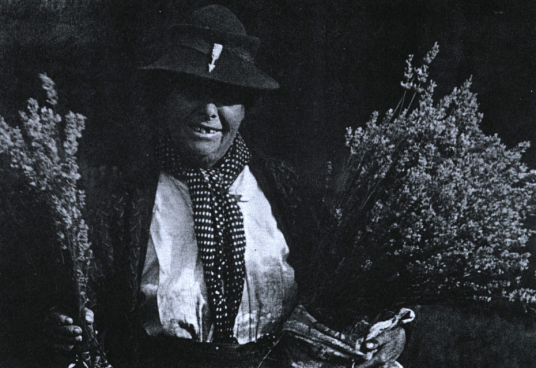
This Newsletter contains printed materials recovered using OCR technology
| 1. Newsdesk |
|
| 2. Wandle Industrial Museum Web Page | We have joined the world wide web |
| 3. Visit to Cobham Mill |
A proposed visit to Cobham Mill |
| 4. Cobham Mill |
Cobham Mill's explanation of the flour milling process |
| 5. Mill machinery |
An explanation of the different parts of a watermill and their strange names |
| 6. Haunted by Wheels |
Stephen Ashcroft can't get away from waterwheels |
| 7. Lavender Grows Again |
A rebirth of Mitcham lavender in Carshalton, courtesy of Bioregional Development Group and HM Prison Downview |
| 8. Mitcham's Coat of Arms |
Mitcham's Coat of Arms |
| 9. Old Mitcham 1926 |
Extracts from 'Old Mitcham', published to celebrate the 1926 centenary of the rebuilding of Mitcham Parish Church |
The Vestry Hall Annexe - London Road - Mitcham
Surrey - CR4 3UD - Telephone 0181 648 0127

Museum open every Wednesday 1 - 4 pm
and first Sunday of each month 2 - 5 pm
The Museum also welcomes schools and groups by appointment
ADMISSION : ADULTS 20p CHILDREN & SENIOR CITIZENS 10p
VISITORS TO THE MUSEUM We had a successful first visit from the Jan Malinowski Centre for adults with learning difficulties in March, and are expecting a group visit from Richmond Ramblers Association in April.
OUTREACHI escorted the Richmond branch of the Ramblers Associationaround the Savacentre site and Liberty site, including a visit to the Merton Priory Chapter House site. Many thanks to member Judith Goodman, who kindly stood in for Peter Harris and lectured to the Richmond Ramblers on the River Wandle. Both the lecture and the tour were very much appreciated by the group.
MEMBERS EVENTS Present It is too early to report on the outing to Medwav Live Industrial Museum and Fort Am hurst with the Merton Scientific Society. A report will go outAn outing to the House Mill at Bromley by Bow is hoped to be planned for the Autumn.
DATES FOR YOUR DIARYN.B. Once again it is time for the National Trust Fayre at Morden Hall Park. The Fayre runs from 1st - 3rd May inclusive and is open from 10.00 a.m. until 6.00 p.m. each day. The theme this year is Robin Hood As this is our main fund-raising event of the year we do hope as many of you as possible will help by manning our stall for part of the three day event. The usual postcard reply is included with this Newsletter and offers of help will be very much appreciated.
MUSEUMS WEEK This year it runs from Saturday 15th May to Sunday23rd May. Once again Merton Heritage Officer, Sarah Gould, is organising another Borough Coach Tour to include a visit to the Wandle Industrial Museum. The tour will be on Saturday 22nd May and the Museum will be open until 2.00 p.m. that day. Watch the local Press for further details.
WANDLE INDUSTRIAL MUSEUM MEMBERSHIP There are still a few Members who have not yet renewed their 1998-99 subscriptions. A reply slip is included for those Members who have not yet responded.
Mary HartWandle Industrial Museum Web Page
The committee have agreed that a presence on the World Wide Web is an important move forward for the museum. Not only does it allow us to reach a world wide audience, but it opens the possibility of a sounder financial future through our book and pamphlet sales, or even a long distance membership. That is the theory, anyway. Foolishly I volunteered to create, and put on the web, our first trial site, to test the water. Creating the site, using one of the latest word processing programs, was not a great problem, although I now appreciate even more the information I had ignored - this is time consuming! Having created it, though, and demonstrated it proudly at the last committee meeting, it is still not there. I have managed to get one (wrong) page on to the web, and by all means, those of you who have a connection, please look. It can be found at http://www.wandleindustrialmusem.freeserve.co.uk I will keep trying, and, with the help of my sons, hope a real site will develop there shortly. Nicholas Hart





They selected a place on the river where thev could make a dam, with a controllable head of water, and set a waterwheel in the river and linked it to a pit wheel inside a mill building. Their problem was that the grinding stones, to work efficiently, had to turn fast, about fifteen times as fast as the river turned the waterwheel.
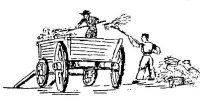
They introduced four gear wheels (the Pit Wheel, the Wallower, the
Spur Wheel and the Stone Nut) between the Waterwheel and the top
grinding stone. Each was quite different in size, some with many teeth,
some with only a few - and these gears produced the required increase
in speed.
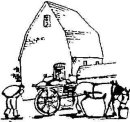
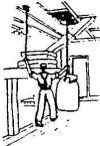
Farmers from miles around would thresh their grain and bring it to Cobham Mill The Miller would hook a sack of grain onto the sack hoist powered by one of the gear shafts and raise it through a trap door to the level of the storage bins The sack was emptied into one of the bins anthe grain let down through wooden chutes and canvas tubes to the hopper above the grinding stones
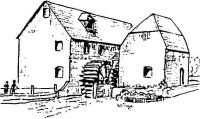
Sometimes the Miller kept some of the flour as payment - sometimes the farmer paid
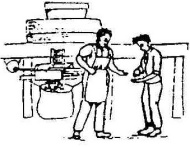 him in cash In the l9th century Cobham Mill
consisted of two buildings. Barley or wheat
could be ground in one and, perhaps. oats or rye
in the other. The fineness of the grind depended.
in part on the kind of grinding stone used. Some
worn stones were found al Cobham Mill and can
now be seen set in the grass outside.
him in cash In the l9th century Cobham Mill
consisted of two buildings. Barley or wheat
could be ground in one and, perhaps. oats or rye
in the other. The fineness of the grind depended.
in part on the kind of grinding stone used. Some
worn stones were found al Cobham Mill and can
now be seen set in the grass outside.
Bread was always the basic food in England for both rich and poor. The importance of a watermill cannot be measured today.
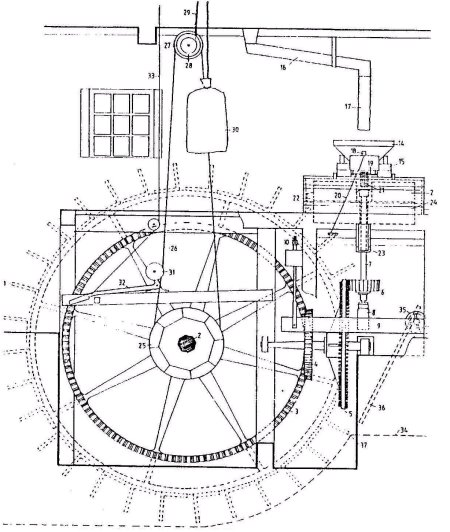
The waterwheel (1) has 32 oak paddles and is mounted on an iron axle-tree (2) which passes into the building, where it supports the 10ft diameter cast iron pit wheel (3). This meshes with the wallower (4) which is mounted on the same horizontal axle as the spur-wheel (5) with its 96 cherry-wood teeth. This, in turn, drives the stone-nut (6) . through which passes the vertical spindle (7) which powers the grinding mechanism. The spindle bearing is supported by the bridge-tree (8), the end of which is notched over the tentering arm (9), which is positioned by a tentering adjuster (10) to set the clearance between the upper running stone (11) (supported and turned by the spindle) and the lower, fixed bedstone (12). between which the grain is ground. The stones are enclosed in a circular tun (13) , surmounted by the hopper (14) , which sits on a horse (15).
From the bins in the roof space, the grain is led through a feed chute (16) and canvas feet) tube (17) into the hopper. From here it passes to the stones through the feed control (18) byn way of a vibrating shoe (19), with its control cord (20), and agitated by a damsel (21) as it falls between the stones .After grinding, the milled flour is directed by a scraper (22) fixed to the running stone to the flour shute (23), from which it is collected in bags. The whole assembly is mounted on a sturdy oak hurst frame (24).
The main axle tree also carries a sack hoist drive wheel (25). which rotaties the sack hoist drum (26). This has a chain (27) running over a pulley at the apex of the roof, which raises the sacks of grain (30) to the storage bins above. The belt is engaged when requireid by means of a jockey pulley (31) operated by a lever (32) raised from either the hurst frame or the floor above, by a control cord (33).
The speed of the waterwheel is governed by the rate of flow in the head race (34) which feeds it; and by operat ion of a sluice control (35) , which positions the sluice (36) to govern the flow of water to the invert (37) at the point where it strikes the paddles
Gear Ratios: Pit wheel to wallower = 120/35 = 3.4
Spur wheel to stone nut = 96/22 = 4.3
Waterwheel to runner stone = 3.4 x 4.3 = 15
This means that for every rotation of the waterwheel the running stone turns 15 times; so if the wheel rotates six times each minute the stone is rotating at 90 times per minute.
Have you ever been stalked?
I haven't - at least, not by a person.
But ever since I joined the Wandle Industrial Museum, I've been haunted by water wheels. Wherever I go, they're there, lurking among reeds, squatting in streams, hiding behind mills.. .watching me. I can't escape them.
This Summer, 1 was sure I'd escape them. I booked a holiday on Kefalonia (don't you go there. I want to go back and I don't want it crowded). Who would build a water wheel on a Greek island? The water-courses only run in Winter, don't they? Sea, sun, scrub-fires and no water wheels\ Who could ask for more?
Some hopes. Kefalonia is limestone. It's a porous island. The rain in Winter sets up a syphon action which lasts all year. At one point on the coast, seawater flows into the land. It goes on underground, gradually absorbing more fresh water and finally emerges 17 km away, 80% fresh water and only 20% brine.
And, you guessed it, where it enters the land, someone built a mill with water wheel powered by sea water. Of course, the 1953 earthquake flattened almost every building on the island, the Mill's not been rebuilt, but the wheel has - as a tourist attraction. And where the water flows back into the sea, they've built another wheel - just for decoration. I can't get away from them.
Get a hold of yourself, Stephen. Try weekend in the Netherlands. Archetypal windmill territory.
The town of Helmond was ideal. Flat land (lots of wind) and slow, lazy canals kept decently away from the town centre. I felt as safe as houses, and I don't mean wheel houses.
On the Sunday we went to Heeze for the Brabant day celebrations (I was with Greensleeves Morris Men and, with our hosts Helmond MM, we were to entertain people before the procession started).
The procession was great. Fantastic floats. One was a full-size cathedral organ. One had a ship floating on water on the float. And one had - oh, no! - a water wheel. A full size water wheel on the float, turned mechanically, I grant (they're damned clever these wheels), but a definite water wheel giving power to two mills (all this on the float, mark you) - one a traditional corn mill and the other bleaching callico. The millers and their hands were all on the float as well.
OK, water wheels. I know when I'm beaten. Call off your troops. I surrender! tephen Ashcroft
The local Lavender project, developed as a partnership project between BioRegional Development Group, a Carshalton based environmental charity, and H.M. Prison Downview is reviving the historic lavender industry in South London as a sustainable community based enterprise. The project is making use of neglected land and plant donated by local residents, while providing additional income and work experience to disadvantaged groups.
The cultivation of lavender, aromatic plants, culinary and medicinal herbs as well as the production of essential oils was, for several centuries, an integral part of the landscape and economy of South London - particularly around Mitcham, Beddington and Carshalton internationally famous fragrance and herbal companies such as Potter & Moore and Yardley built their reputation using plant and extracts from the area. However, during the interwar years fields were built on for housing and commercial production stopped. The project objectives are the revival of local land based enterprises and pride in the local heritage, while working toward social, economic and environmental aims.
In 1995, following the production of a feasibility study on lavender and mint growing by BioRegional, press releases in local newspaper called for help and information to revive the industry in a smaller form. Following this, local people, mainly elderly residents offered cuttings from lavender bushes kept alive from the original fields. Cuttings from these bushes were taken by community volunteers and the horticultural unit of the local prison HMP Downview, offered to grow the cuttings, with BioRegional supplying growing material and technical assistance. The first harvest of lavender flowers have been dried and made into lavender bags by the Hallmead Centre for people with learning difficulties and sold through their craft centre at Oaks Park in Carshalton.
Over the past two years, 12,000 lavender plants have been grown by offenders at HMP Downview, and offenders on day release have planted the first large lavender field in the area since eighty years. To date 2.5 acres (1.2 hectare) have been planted on disused allotment plots released by Sutton Borough Parks Department for environmental initiatives which protect public open space from development. The newly planted field is situated in Carshalton on the Stanley Road allotments on a site where lavender and mint was grown until 1938. Adjacent to the site is the old lavender and mint distillery building, now occupied by a furniture maker.
This year another disused allotment site at Bute Road Orchard in Wellington will be
cleared, cultivated and planted with lavender. This site also has historical links with
the lavender industry as lavender was grown there and a distillery in Bute Road
operated until 1950. The beginning of the new millennium may well see the
reintroduction of lavender, mint and herbs growing close to Mitcham at Beddington
corner. This area was for over two centuries the world centre of lavender and mint
production and the BioRegional Development Group is working on a proposal to
reintroduce lavender production on the site when gravel extraction and landfilling
operations are completed. A prospect we hope, most Mitcham residents and
historians would welcome! ...H. le Reverend
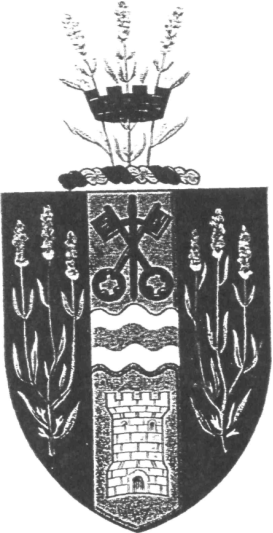
MITCHAM Borough Council 1934-1965
ARMS
The shield consists of a Pale Vert, which brings in the colour green, for which Mitcham is famous. In the centre is a Fesse wavy charged with a Barulet wavy, which indicates the River or Ford - as the upper part of Mitcham was formerly called Witford or Waterford. Below is a Tower which represents the Great Dwelling or Mitchelham -which the lower part of Mitcham was formerly called. Above are Cross-Keys and a Sword representing St. Peter and St. Paul who are the patron saints of Mitcham. On each side is a Sprig of Lavender.
CREST
Three Sprigs of Lavender entwined by a Mural Coronet.
MOTTO
Mitcham Faeste Gestandep (Mitcham Stands Fast).
How beautiful were the fields of poppies, lavender, camomile, and
Provence roses,
when in full bloom! Then, indeed, Mitcham was well described as the Garden
Village of Surrey. The camomiles were usually mature and ready for
picking about
fair time, and a large number of children were able to set aside a portion
of their
earnings for the fair pleasures. The scent from the distilleries at autumn
time was a
distinct feature too, and those passing through Mitcham were made aware
of the
presence of the famous herb growing village. ... ...J.D.Drewett
In 1745 Mitcham was greatly alarmed by the report that the Pretender's troops, having defeated those of King George at Derby, were marching on to attack London, and that our village was marked for ravage en route by the wild Highlanders. How Mitcham would be in the way of the Pretender's victorious troops passing from Derby to London is by no means clear, but if the geography was weak, the alarm was very genuine, and an old-time Worsfold assembled his fellow villagers on the front lawn at The Hall Place, armed them with flails, scythes and bill hooks, gave them a patriotic address, and called on them to rise and fight for King and Country. Whether fear or the lack of oratory was the cause, I know not, but when my ancestor had finished his speech, not a single man responded to the call to action until he had supplied them with three barrels of his best October brew. Then only, when the last drop obtainable had been consumed, did their valour assert itself, and they demanded to be led out against the savage Scots. This was the tale told to me by an old lady forty-five years ago, who was then in her 90th year. Her family had been our tenants for well over a century, and as she had heard the tale from her mother, who had witnessed it as a young girl, so she repeated it to me.
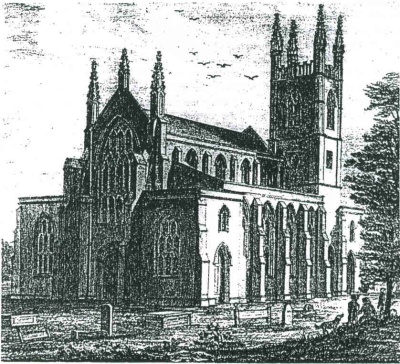
Another remarkable article of public service was a venerable locomotive
employed to draw the early morning train to Wimbledon. This was used
by a considerable number
of regular passengers who, after a time, were much annoyed by the
failure of the
engine to draw the train into Wimbledon Station, which meant getting out
and
walking along the line. It was the last hundred yards that proved too
much for the
poor old thing, worn out by years of faithful service. At length, on the representation
of the aggrieved passengers, it was taken off, a substitute being supplied
for what we
called "The Old Tea Kettle." ... ...Sir Cato Worsfold
Another well-known resident in those old days in the beginning of the
last century-
was Mr. Swain, a medical practitioner. At night he rode on horseback, as
was the
universal custom at that time. One night he was stopped by highwaymen, who
accosted him in their usual manner, "Your money or your life!" He
begged they
would not detain him, as he was only a doctor on his way to see a patient
who was
very seriously ill, and delay might be dangerous. Hearing this, they politely
apologised, saying had they known he was a doctor they would not have interfered
with him. ...Miss Hartley
A pretty feature was the passing daily through Mitcham of Charrington's flour
waggons, real old four-wheeled waggons with circular tilt, four fine Flemish
horses to
each one - and waggoners with smocks, broad brim hats and whips; also the Gamer's
Cart daily to London J. D. Drewett
An incident in connection with the carving of the heads by the sides of the windows near the top of the Church was told me by my father. The gentleman who was carving these sculptured faces was annoyed for some days by an old lady living in one of the old houses opposite, who used to lean over the back of a chair at her open window and made uncalled-for remarks. He said, "I will have you for one of my portraits," and with that he chiseled out her face with a comic expression, leaning over a shield
(in the place of a chair). It was considered an excellent likeness in caricature
.............. ... ..............J. R. Chart
From "Old Mitcham", published in connection with the centenary of the rebuilding of Mitcham Parish Church, 1926. Edited by LtCoI.H.F.Bidder